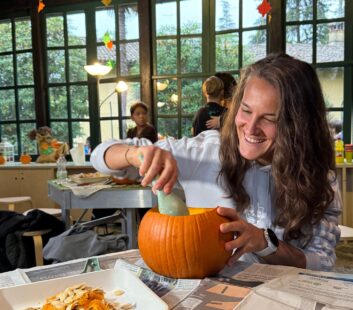
LIFESTYLE
Orticolario: The Wild Eden of Lake Como
“A garden is not a plot—it’s a proposition.”
“At Orticolario, even stillness hums with intention.”
“Come for the spectacle. Stay for the stillness.”
There are few places that wear beauty so effortlessly as Lake Como in October. The summer crowds have thinned, the light begins to soften, and the gardens—those manicured emblems of Italian order—start to loosen their collars. And then, quite suddenly, something else takes root.
From October 2 to 5, 2025, Orticolario returns to Villa Erba, the 19th-century estate once home to Luchino Visconti, for its fifteenth edition. Described as a “cultural event for those who live nature as a style of life,” Orticolario is not so much a garden show as it is a declaration: that the garden can be a place of provocation, sensuality, design—and above all, storytelling.
Each year, Orticolario chooses a theme to frame its gardens and installations. For 2025, that theme is “Eden.” But not the Eden of innocence and symmetry. This is Eden as rupture, as possibility. The kind where thorns aren’t clipped, nature pushes back, and paradise is a little bit wild.

It’s an inspired prompt in a world increasingly obsessed with control. Here, visitors are encouraged to consider what Eden might look like today—lush, yes, but also uncertain. Beauty with an edge. The curators speak of “a contemporary Garden of Eden” where man is no longer the central protagonist, but a guest—one with the humility to observe rather than dominate. It is an idea as philosophical as it is horticultural.
Orticolario was first held in 2011. Back then, it was a charming if understated gathering, with fewer than 20,000 guests and just over 200 exhibitors. But it has since flourished into something of a cultural bellwether, drawing over 25,000 visitors annually and more than 250 exhibitors, from rare-plant growers to conceptual landscape designers.
The scale is significant, but it’s the mood that sets Orticolario apart. Walking through the Villa Erba gardens in early autumn is like stepping into a dream staged with botanical precision and artistic intent. There are no sterile rows of booths here—only installations that speak, whisper, challenge.
Among the most anticipated works this year is “DZONOT”, a site-specific installation by Jonathan Arnaboldi and Matteo Pellicanò. Taking its name from the Mayan word for a natural sinkhole, the piece will anchor the exhibition’s main pavilion in an immersive spiral of trees, evoking the sacred relationship between humans and ancient ecosystems. Sponsored by Fondazione BPM and STIHL, the work fuses Mediterranean species, structural elegance, and spiritual undertones—suggesting, perhaps, that Eden is not a place but a portal.
Also debuting is AREA *— a new curated space where contemporary makers present everything from sculptural furniture to hand-thrown ceramics. It’s Orticolario’s most modern offering to date: an intersection between craft and consciousness, offering a slower, more tactile counterpoint to the spectacle outside.
It’s no surprise that Orticolario has become a favorite among Italy’s design set. In previous years, the event has seen figures from the world of fashion—Rita Missoni, Wanda Ferragamo—lend their names to plants and participate in unveiling ceremonies. There is talk of another major name appearing this year, a designer known for her sculptural silhouettes and deep ties to sustainable materiality. Nothing is confirmed, of course. Orticolario tends to keep its glamour discreet.

But it’s there in the details: the way the gardens unfold like gowns, the soft choreography of shadows and petals across the gravel paths, the echo of water lapping against the stone terraces of Villa Erba. The landscape here doesn’t just frame the work—it is the work.
What makes Orticolario singular is its refusal to treat gardens as static, pretty things. Each edition asks urgent questions—about ecology, about aesthetics, about our place within living systems. Previous themes have included “Phytodepuration” and “Sense of Water”—concepts that merge beauty with biology, calling attention to the intelligence of plants, the politics of soil, the role of the gardener as not just a designer, but a listener.
This year’s “Eden” is no different. It’s both metaphor and manifesto. One designer speaks of creating “spaces of contradiction,” gardens that offer shade and provocation in equal measure. Another is planting a soundscape into his installation, using low-frequency vibrations to “speak” to the plants.
At Orticolario, even stillness hums with intention.
And then, of course, there is the villa itself. Villa Erba, with its frescoed ceilings, grand rotunda, and cinematic past, is not merely a venue—it is the soul of the event. Once the summer home of the Visconti family, its gardens slope gently toward the lake, dotted with ancient plane trees and secret corners that seem built for whispered conversations. It is a space suspended in time—simultaneously decadent and humble, overgrown and ordered.
No other site could hold Orticolario the way this one does. Here, amid hydrangeas and hornbeams, the event finds its rhythm—neither nostalgic nor futuristic, but precisely now.

There is something deeply elegant—and deeply radical—about Orticolario’s quiet insistence that the natural world be treated as an equal collaborator. At a time when culture so often demands speed, opinion, performance, this is a place that rewards attentiveness. A leaf is not just a leaf, but a gesture. A garden is not just a plot, but a proposition.
And when evening falls and the lake begins to mirror the garden lights, Orticolario becomes something else entirely. A gathering of aesthetes, designers, plant whisperers, and the simply curious. A reminder that style, at its best, is never separate from nature — it grows from it.
Come for the spectacle. Stay for the stillness. And leave with a new understanding of what beauty might look like, when we allow it to go just a little bit wild.



